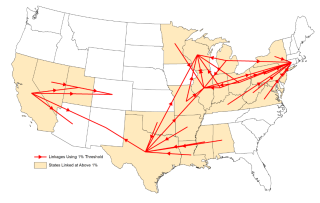
Today’s example of how the critics of environmental regulations ignore the benefits: Clean Neighbor Rule
From the NYTimes (E.P.A. Tells Dozens of States to Clean Up Their Smokestacks):
The Biden administration on Wednesday finalized a rule forcing factories and power plants in 23 Western and Midwestern states to sharply cut smog-causing pollution that is released from their smokestacks and fouls the air in Eastern states.
Known as the “good neighbor” rule, the new regulation strengthens and expands an earlier interstate air pollution standard that was enacted during the Obama administration. While that rule directed power plants to clean up their emissions, the revised rule enforces similar controls on mills, factories and other industrial facilities.
Here is EPA’s website for the Good Neighbor Rule: https://www.epa.gov/… (that’s where I got the map). Click on the Regulatory Impact Analysis link to see the numbers for the benefits and costs referenced below.
The Environmental Protection Agency is required by the Clean Air Act to periodically review and revise the rule. After failing do so during the Trump administration, it is now strengthening restrictions under a court-ordered deadline.
The good neighbor rule holds that states should take measures to ensure that their pollution doesn’t affect downwind states. It directs coal-burning power plants and industrial facilities such as iron, steel, cement and concrete manufacturers in the Western and Midwestern states to reduce their emissions of nitrogen dioxide, a pollutant that causes smog and is linked to asthma, lung disease and premature death.
Soot and exhaust belched from those industrial facilities is carried by prevailing winds toward Eastern states, causing high levels of pollution in states with fewer industries. …
The tighter rules on power plants will come into force later this year, while the new controls on factories and other industrial polluters will take effect in 2026. …
The E.P.A. estimates that the updated good neighbor rule will cut emissions of nitrogen oxide in the affected states by 50 percent from 2021 levels by 2027, preventing 1,300 premature deaths, avoiding more than 2,300 hospital and emergency room visits, preventing 1.3 million cases of asthma and avoiding 430,000 lost school days and 25,000 missed work days. …
If the EPA is using a value of mortality risk reduction estimate equal to $10 million per life saved (I used up my time budget and still couldn’t find the number in the RIA) then those benefits are $11.3 billion.
The critics are funny.
… Senator Joe Manchin, Democrat of West Virginia, has raised concerns about the costs to power plants and manufacturers to comply with the strengthened rule, saying it could force some plants to shut down or reduce operations, threatening the reliability of electric grids. Mr. Manchin wrote Mr. Regan last week to ask him to postpone action.
The costs are real but I’m fairly sure it won’t threaten the reliability of electric grids. If I’m way out there on this one please let me know.
Scott Segal, a lobbyist for Bracewell LLC, which advocates for coal plants and industrial manufacturers, said the cement industry would also feel the brunt at a time when its products are in demand because of a recent influx of federal investment in road and bridge construction.
“The bipartisan infrastructure law anticipates substantially increased use of building materials manufactured here in the United States, a policy objective seemingly at cross purposes with the rule,” Mr. Segal said.
The cement industry logic is that if the government increases the demand for cement then it shouldn’t regulate the increased pollution the cement industry will cause.
The E.P.A. estimates the cost of complying with the revised rule to be about $910 million annually from 2023 to 2042, while the net economic benefits of the associated public health gains would be up to $13 billion each year over the same time period.
That’s not really a good summary of the present value of net benefits. First, delete “net” and “up to” since $13 billion is the annualized value equivalent to the $910 million number (see Table ES-15 of the RIA below the fold). The present value of the net benefits from 2023 to 2042 is $200 billion with a 3% discount rate and $140 billion with a 7% discount rate.
Other manufacturers, which have in the past joined industrial states in legal action to block the rules, have been wary of the updated versions.
“While the intent of this proposal is right and one that we share, it could have significant effects on American families if not thoughtfully implemented,” said Aric Newhouse, senior vice president of policy and government relations at the National Association of Manufacturers, when the E.P.A. first proposed the updated regulation last year.
“We must be careful with regulations that could further raise prices on all Americans, slow economic growth and threaten jobs,” Mr. Newhouse said.
When the benefits exceed the costs one play in the playbook is to raise the scare of macroeconomic impacts. I don’t know of any credible evidence that environmental regulations have had much macroeconomic impact in the U.S. since 1970. They lead to lost jobs in polluting industries but these jobs move to other sectors of the economy.
Conclusion: The critics of environmental regulations (Manchin and the manufacturing industry) ignore the benefits of environmental regulations, especially when the benefits exceed the costs.
This is from page 45 of the RIA:



